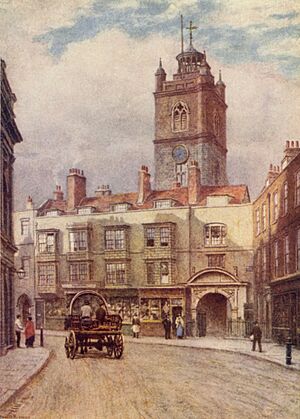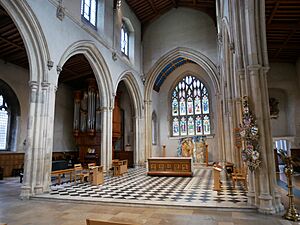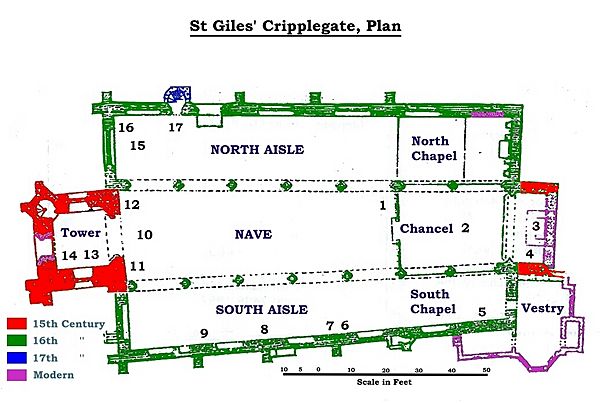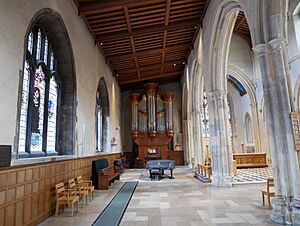St Giles-without-Cripplegate facts for kids
Quick facts for kids St Giles-without-Cripplegate |
|
|---|---|
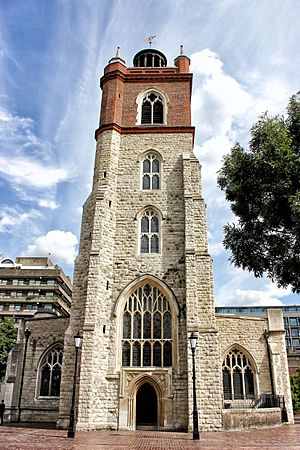
The west tower of St Giles-without-Cripplegate
|
|
| Location | London, EC2 |
| Country | England |
| Denomination | Church of England |
| Previous denomination | Roman Catholic |
| Website | http://www.stgileschurch.com |
| History | |
| Founded | 1394 |
| Architecture | |
| Heritage designation | Grade I listed building |
| Style | Perpendicular Gothic |
| Administration | |
| Parish | St Giles' with St Luke's |
| Diocese | London |
St Giles-without-Cripplegate is a historic Church of England church in the City of London. It is located inside a modern housing area called the Barbican.
The church's name tells a story about its location. When it was first built, it stood "without," or outside, the old city wall. It was near a gate in the wall called Cripplegate. The church is named after St Giles, who is the patron saint for people with disabilities.
St Giles-without-Cripplegate is special because it is one of the few old churches left in the City of London. It survived the Great Fire of London in 1666, a huge fire that destroyed much of the city.
Contents
History of the Church
The story of this church goes back over a thousand years. An early Saxon church stood on this spot in the 11th century. Around 1090, a new church was built in the Norman style.
In 1394, the church was rebuilt again. This time, it was in a style called Perpendicular Gothic, which was popular at the time. The stone tower that you can see today was added much later, in 1682.
Surviving Fires and Bombs
The church has faced destruction from fire three times. The first fire was in 1545, and the second was in 1897.
The worst damage happened during World War II. In an air raid known as the Blitz, German bombs hit the church and completely destroyed the inside. However, it was carefully restored. Builders used the original 1545 plans to rebuild it, bringing it back to its former glory.
After the restoration, a new set of twelve bells was made for the tower in 1954. In 1959, when a nearby church called St Luke's on Old Street closed, its historic pews, altar, and font were moved to St Giles.
Because of its long and important history, the church was made a Grade I listed building on January 4, 1950. This means it is officially recognized as a building of special architectural and historic interest.
Famous People Connected to the Church
Many famous people from English history have connections to St Giles-without-Cripplegate.
- Sir Martin Frobisher (died 1594) was a famous explorer and a sea captain. He helped defend England against the Spanish Armada. He is buried in the church.
- Oliver Cromwell (1599–1658) was a military leader who became the Lord Protector of England. He married his wife, Elizabeth Bourchier, in this church in 1620.
- John Milton (1608–1674) was one of England's greatest poets. He wrote the epic poem Paradise Lost. He is buried in the church.
- John Bunyan (1628–1688) was a writer and preacher. He wrote the famous book The Pilgrim's Progress. He often attended services at St Giles.
- Daniel Defoe (c. 1660–1731) was the author of the classic adventure novel Robinson Crusoe. He died in the parish of St Giles.
- Rick Wakeman (born 1949) is a modern musician, famous for playing keyboards in the band Yes. He recorded music on the church's pipe organ for his album The Six Wives of Henry VIII.
Inside the Church
The church is filled with interesting historical items and memorials. Many of these came from the nearby church of St Luke's, Old Street, which was closed in the 1960s.
Inside, you can find the graves of the poet John Milton and the writer John Foxe, who wrote a famous book called The Book of Martyrs. There are also memorials and statues dedicated to important figures. A bust (a sculpture of a person's head and shoulders) of John Milton stands near the organ. There are also busts of Oliver Cromwell, John Bunyan, and Daniel Defoe.
A plaque on the wall honors the explorer Sir Martin Frobisher. Another honors the map maker John Speed. The beautiful stained-glass windows also show the coats of arms of Milton, Cromwell, and Frobisher.
Gallery
See also
- List of buildings that survived the Great Fire of London
- List of churches and cathedrals of London


